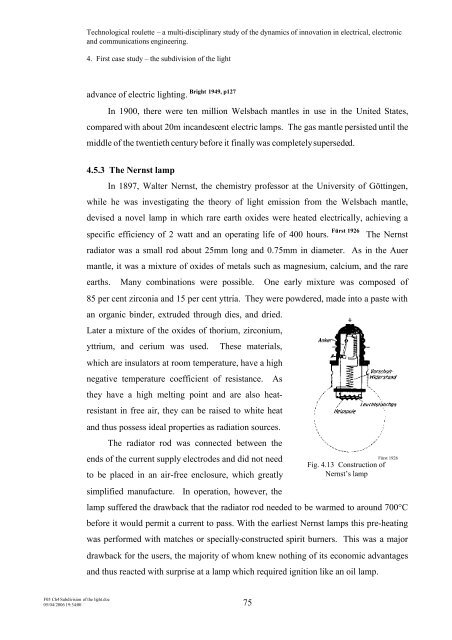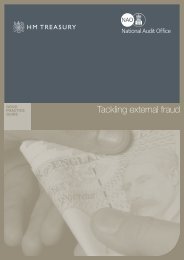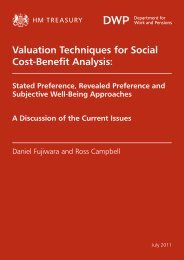4. First case study – the subdivision of the light - HM Treasury
4. First case study – the subdivision of the light - HM Treasury
4. First case study – the subdivision of the light - HM Treasury
Create successful ePaper yourself
Turn your PDF publications into a flip-book with our unique Google optimized e-Paper software.
F05 Ch4 Subdivision <strong>of</strong> <strong>the</strong> <strong>light</strong>.doc<br />
05/04/2006 19:34:00<br />
Technological roulette <strong>–</strong> a multi-disciplinary <strong>study</strong> <strong>of</strong> <strong>the</strong> dynamics <strong>of</strong> innovation in electrical, electronic<br />
and communications engineering.<br />
<strong>4.</strong> <strong>First</strong> <strong>case</strong> <strong>study</strong> <strong>–</strong> <strong>the</strong> <strong>subdivision</strong> <strong>of</strong> <strong>the</strong> <strong>light</strong><br />
Bright 1949, p127<br />
advance <strong>of</strong> electric <strong>light</strong>ing.<br />
In 1900, <strong>the</strong>re were ten million Welsbach mantles in use in <strong>the</strong> United States,<br />
compared with about 20m incandescent electric lamps. The gas mantle persisted until <strong>the</strong><br />
middle <strong>of</strong> <strong>the</strong> twentieth century before it finally was completelysuperseded.<br />
<strong>4.</strong>5.3 The Nernst lamp<br />
In 1897, Walter Nernst, <strong>the</strong> chemistry pr<strong>of</strong>essor at <strong>the</strong> University <strong>of</strong> Göttingen,<br />
while he was investigating <strong>the</strong> <strong>the</strong>ory <strong>of</strong> <strong>light</strong> emission from <strong>the</strong> Welsbach mantle,<br />
devised a novel lamp in which rare earth oxides were heated electrically, achieving a<br />
specific efficiency <strong>of</strong> 2 watt and an operating life <strong>of</strong> 400 hours. Fürst 1926 The Nernst<br />
radiator was a small rod about 25mm long and 0.75mm in diameter. As in <strong>the</strong> Auer<br />
mantle, it was a mixture <strong>of</strong> oxides <strong>of</strong> metals such as magnesium, calcium, and <strong>the</strong> rare<br />
earths. Many combinations were possible. One early mixture was composed <strong>of</strong><br />
85 per cent zirconia and 15 per cent yttria. They were powdered, made into a paste with<br />
an organic binder, extruded through dies, and dried.<br />
Later a mixture <strong>of</strong> <strong>the</strong> oxides <strong>of</strong> thorium, zirconium,<br />
yttrium, and cerium was used. These materials,<br />
which are insulators at room temperature, have a high<br />
negative temperature coefficient <strong>of</strong> resistance. As<br />
<strong>the</strong>y have a high melting point and are also heat-<br />
resistant in free air, <strong>the</strong>y can be raised to white heat<br />
and thus possess ideal properties as radiation sources.<br />
The radiator rod was connected between <strong>the</strong><br />
ends <strong>of</strong> <strong>the</strong> current supply electrodes and did not need<br />
to be placed in an air-free enclosure, which greatly<br />
simplified manufacture. In operation, however, <strong>the</strong><br />
lamp suffered <strong>the</strong> drawback that <strong>the</strong> radiator rod needed to be warmed to around 700°C<br />
before it would permit a current to pass. With <strong>the</strong> earliest Nernst lamps this pre-heating<br />
was performed with matches or specially-constructed spirit burners. This was a major<br />
drawback for <strong>the</strong> users, <strong>the</strong> majority <strong>of</strong> whom knew nothing <strong>of</strong> its economic advantages<br />
and thus reacted with surprise at a lamp which required ignition like an oil lamp.<br />
75<br />
Fürst 1926<br />
Fig. <strong>4.</strong>13 Construction <strong>of</strong><br />
Nernst’s lamp





![AIRTO [Professor Dr Brian Blunden] - HM Treasury](https://img.yumpu.com/15492848/1/184x260/airto-professor-dr-brian-blunden-hm-treasury.jpg?quality=85)










